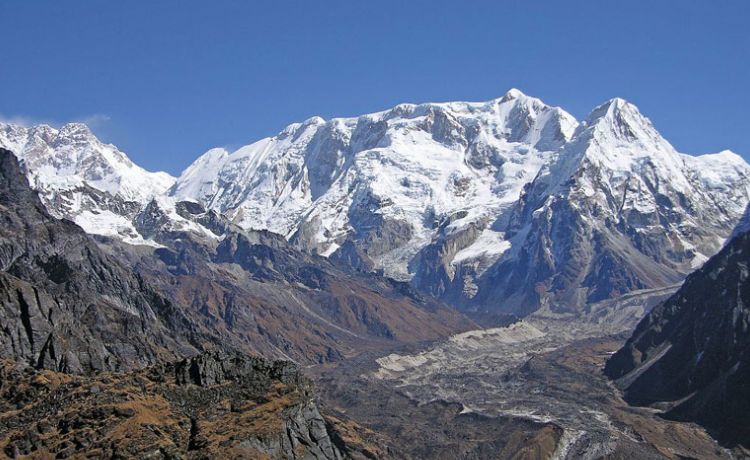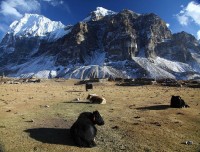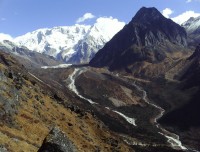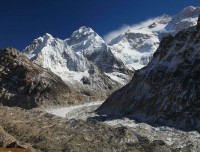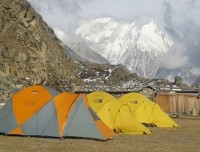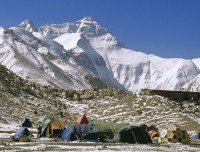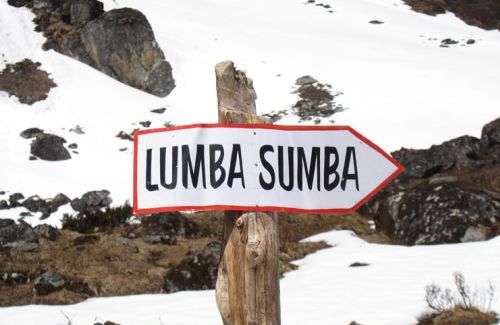Kanchenjunga Site Trekking
- Duration28 Days
- Max. Altitude5,140 m
- Starts FromUSD 3125
Destination:Nepal
Trip Grade:Strenuous (****)
Meals:Breakfast + Lunch + Dinner
Transportation:Private Vehicle / Aeroplane
Accommodation:Camping
Trekking Region:Kanchenjunga Region
Show All
Kanchenjunga Site Trekking refers to Kanchenjunga Base Camp Trekking. Mt. Kanchenjunga (8,586m) is third highest peak in the world. This is unexplored and unspoiled trekking route lying in the eastern part of Nepal. Kanchenjunga Base Camp Trekking is really a rewarding one as this region offers amazing snow - capped mountains, landscape and exotic panoramic view of the Himalayas.
Kanchenjunga Base Camp Trekking route can be used from Nepal and Sikkim side too. There are many mysterious stories of Himalayan YETI, the abominal snowman is believed to be found in this region. Kanchenjunga trek is a special and memorable one. Trek Kanchenjunga is not only to have a view of the landscape but also to enjoy the wildlife during the trekking. Kanchenjunga Base Camp trekking has more exciting and adventurous trekking trail through Kanchenjunga Conservation Area which is spread over 2,035 Sq km, rich in wildlife diversity with many endangered species of birds like pheasant, red-billed blue magpie, shy dragon, amphibians and mammals.There are animals including snow - leopard, Himalayan black bear, musk deer red panda many more, well protected in this region.
Kanchenjunga Base Camp trek begins with guided city sightseeing in the historical places listed in the World Heritage Sites. We visit exquisite temples and ornately decorated stupas in Kathmandu Valley. We explore the unique cultural norms and values existed in the well harmonized ethnic communities. After city sightseeing, we fly from Kathmandu to Suketar,Taplejung by domestic airlines or drive from Kathmandu to Basantapur via Dharan Bazaar. Trek Kanchenjunga Base Camp begins from Basantapur along the ridge to Tinjure Danda and reaches to Guphapokhari. From Guphapokhari, we continue east along the subsidiary ridge through the dense forest and reach to Dobhan passing Guri and Nesum villages.
Then, we cross the bridge over Timur and following the river bank, we arrive at Chhirwa. After the trek to Sekathum, Amjilessa, Gyapla and Ghunsa Village, we reach to Kambachen.where we spend a day for acclimatization. From Kambachen, we trek to Lhonak and reach to Pang Pema, the northern base camp. Similarly we reach to Southern Base camp from Tseram.After the great trekking Kanchenjungha Base Camp, we trek down to Ramche, Torontan, Amje Khola, Mamanke, Kande Bhanjyang, Lali Kharka and finally arrive at Suketar. From Suketar, we fly back to Kathmandu and celebrate for our success in the Kanchenjunga Base Camp Trek
Trip Highlights
- Sightseeing at World Heritage Sites in Kathmandu
- Scenic drive from Kathmandu - Dharan - Basantapur
- Exciting flight from Suketar to Kathmandu
- Close up view of Kanchenjunga and Mt. Makalu
- Open for foreign visitors only from 1988
- Paradise for adventure lovers
- Beautiful glaciers of Kanchenjunga
- Lifestyle and culture of ethnic groups: Limbus and Rais
- Pleasant walk through rhododendron forest and terraced fields
- Encounter with Himalayan animals like bear, barking deer and panda
Day to Day Itinerary
Day 01:Arrival in Kathmandu (1,350 m) and Transfer to the Hotel. Overnight at Hotel
Day 02:Kathmandu Valley Sightseeing and Trek Preparation. O/N at Hotel
Day 03:Drive from Kathmandu to Dharan Bazaar (1,540 m), 8-9 hrs. O/N at Guest House
Day 04:Drive from Dharan Bazaar to Basantapur (2,200 m), 4-5 hrs. O/N at Tented Camp
Day 05:Trek from Basantapur to Gupha Pokhari (1,876 m), 5-6 hrs. O/N at Tented Camp
Day 06:Trek from Gupha Pokhari to Dobhan (1,567m), 5-6 hrs. O/N at Tented Camp
Day 07:Trek from Dobhan to Chhirwa (1,190 m), 5-6 hrs. O/N at Tented Camp
Day 08:Trek from Chhirwa to Sekathum (1,640 m), 5-6 hrs. O/N at Tented Camp
Day 09:Trek from Sekathum to Amjilessa (2,490 m), 5-6 hrs. O/N at Tented Camp
Day 10:Trek from Amjilessa to Gyapla/Kypra (2,730 m), 5-6 hrs. O/N at Tented Camp
Day 11:Trek from Gyapla/Kypra to Ghunsa Village (3,430 m), 4-5hrs. O/N at Tented Camp
Day 12:Trek from Ghunsa Village to Kambachen (4,040m), 4-5 hrs. O/N at Tented Camp
Day 13:Rest day at Kambachen. O/N at Tented Camp
Day 14:Trek from Kambachen to Lhonak 4,790 m), 4-5 hrs. O/N at Tented Camp
Day 15:Trek from Lhonak to Pang Pema (5,140 m), (Northern Base Camp), 5-6 hrs. O/N at Tented Camp
Day 16:Trek from Pang Pema to Lhonak (4,790 m), 5-6 hrs. O/N at Tented Camp
Day 17:Trek from Lhonak to Ghunsa (3,430m), 5-6 hrs. O/N at Tented Camp
Day 18:Trek from Ghunsa to Sinion/ Selele Phedi (3,546 m), 5-6 hrs. O/N at Tented Camp
Day 19:Trek from Sinion /Selele phedi via Selele Pass (4,854 m) to Tseram (3,870 m), 6-7 hrs. O/N at Tented Camp
Day 20:Trek from Tseram to Kanchenjunga Base Camp, back to Ramche (4,620 m),5-6 hrs. O/N at Tented Camp
Day 21:Trek from Ramche to Torontan (3,256 m), 5-6 hrs. O/N at Tented Camp
Day 22:Trek from Torontan to Amje Khola (2,340 m), 5-6 hrs. O/N at Tented Camp
Day 23:Trek from Amje Khola to Mamanke (1810 m), 5-6 hrs. O/N at Tented Camp
Day 24:Trek from Mamanke to Kande Bhanjyang (2,134 m), 5-6 hrs. O/N at Tented Camp
Day 25:Trek from Kande Bhanjyang to Lali Kharka (2,213m), 5-6 hrs. O/N at Tented camp
Day 26:Trek from Lali Kharka to Suketar / Taplejung (1,824 m), 5-6 hrs. O/N at Tented Camp
Day 27:Fly from Suketar to Kathmandu (1,350 m). O/N at Hotel
Day 28:Transfer to International Airport
Cost Include
- Airport picks up & drops off by private tourist vehicle
- A government licensed holder city tour guide
- 3 nights’ twin sharing 2-3 star hotels in Kathmandu with Breakfast
- Guided city tour in Kathmandu by private tourist vehicle
- Full board meals (Breakfast + Lunch + Dinner) during the trek
- Tented camp accommodation during the trek
- Professional license holder English speaking Trekking guide
- The required number of local staff and porters to carry your luggage during the trek
- Food, accommodation, salary, insurance, equipment and medicine for all staff
- All required camping equipments during the trek
- Kanchenjunga Special permit, National Park Fees and TIMS permit for trekking
- Down Jacket, Duffle bag and sleeping bag by Himkala Adventure if required
- Public transportation from Kathmandu to Dharan then to Basantapur
- Airfare from Suketar to Kathmandu including airport departure taxes
- Farewell dinner in traditional Nepali restaurant with cultural show
- All our government taxes, vat & service charges
Cost Exclude
- Lunch and dinner in Kathmandu & Pokhara
- Entrance fee in all monuments during tour
- Emergency rescue and evacuation cost
- Your travel insurance
- Nepal entry visa fee which is issued at Kathmandu Airport
- Personal expenses like phone bills, laundry,alcoholic,non-alcoholic drinks etc
- Personal trekking equipment
- Tips for trekking, tour staff and driver (Tipping is expected)
- Any others expenses which are not mentioned on ‘Cost Includes' section
Detail Itinerary
Day 01Arrival in Kathmandu (1,350 m) and Transfer to the Hotel. Overnight at HotelUpon your arrival at Tribhuvan International Airport in Kathmandu, our representative from Himkala Adventure greets you and transfers to hotel at Thamel. You could take rest and get refreshed from jet lag. You could walk around Thamel in your spare time. Overnight at Kathmandu
Day 02Kathmandu Valley Sightseeing and Trek Preparation. O/N at Hotel After breakfast, we begin our guided city tour to the UNESCO World Heritage Sites. These landmarks are historically and spiritually significant. We will visit the old Swoyambhunath Stupa, intricately crafted old palace and temples of Kathmandu Durbar Square, esoteric geometric figured Boudhanath and the Hindus’ holy pilgrimage site Pashupatinath. After the tour, we return back to hotel and brief you about the Makalu Base Camp trekking and prepare for the trek. Overnight at Kathmandu
Day 03Drive from Kathmandu to Dharan Bazaar (1,540 m), 8-9 hrs. O/N at Guest House We drive from Kathmandu to Dharan by bus. Dharan is 481 km west from Kathmandu and takes about 10 hours. This is long bus journey but the changing view from hilly region to the plains of Terai, the living style of people gives anyone the feeling of diversities in such small country. Dharan is a scenic hill town where we find many Gorkha soldiers dwelling there mainly of Rai and Limbu communities. Overnight at Dharan Bazaar
Day 04Drive from Dharan Bazaar to Basantapur (2,200 m), 4-5 hrs. O/N at Tented Camp After breakfast, we drive from Dharan Bazaar to Basantapur. It is about 90 km from Dharan and about 1 km from Hile. Basantapur is the starting point for the trekking to Kanchenjungha Base Camp and Tinjure, Milke Danda, Jaljale. The road to Basantapur from Dharan is bumpy and slow. There are microbuses available nominally in higher price. People can hire jeep or taxi to go to Basantapur as well. Basantapur has few lodges with basic facilities. Overnight at Basantapur
Day 05Trek from Basantapur to Gupha Pokhari (1,876 m), 5-6 hrs. O/N at Tented Camp After breakfast, we climb passing many small settlements and reach to Dorpani Village. We continue along the ridge till we reach at the top of Tinjure Danda. From there, we continue along the ridge and descend down steeply to the village of Chauki. From Chauki, we walk through the villages of Manglebari and Lamo Pokhari. We arrive at Gupha Pokhari, the ridge top village on the edge of Milke Danda. Overnight at Gupha Pokhari
Day 06Trek from Gupha Pokhari to Dobhan (1,567m), 5-6 hrs. O/N at Tented Camp We continue east along the subsidiary ridge through the dense forest. We arrive at the small settlement of Buje Deurali. We descend to the Timur River through rhododendron forest initially and emerge into the countryside. After passing the village of Guri and Nesum, we reach to Dobhan and camp at the meadow between the confluence of Malwa and Timur Rivers. Overnight at Dobhan
Day 07Trek from Dobhan to Chhirwa (1,190 m), 5-6 hrs. O/N at Tented Camp After breakfast, we cross the bridge over Timur River and follow the river bank. Then we continue along the river bank and arrive at Sinuwa. The river narrows into a gorge where we see rushing Tamur River over boulders forming small waterfalls. We can see the large landslide and soil erosion there. We can notice the beehives hanging at the end of the landslide section. Finally we arrive at Chhirwa. Overnight at Chhirwa
Day 08Trek from Chhirwa to Sekathum (1,640 m), 5-6 hrs. O/N at Tented Camp From Chhirwa, we follow the Tamur to the town of Chilaune. We again follow the Tamur River and reach on the confluence of the Tamur and the Ghunsa River, originated from the Kanchenjungha glacier. We camp above the confluence at the village of Sekathum. Overnight at Sekathum
Day 09Trek from Sekathum to Amjilessa (2,490 m), 5-6 hrs. O/N at Tented Camp After breakfast, we follow the Ghumsa River high above on a steep cliff and follow the ridge. We descend steeply down to the small settlement of Amjilessa. At the end of the valley ahead of us, we can see the Sinion and Margin passes, heading towards Kanchenjungha South Base Camp. Overnight at Amjilessa
Day 10Trek from Amjilessa to Gyapla/Kypra (2,730 m), 5-6 hrs. O/N at Tented Camp After breakfast, we go steeply downhill out of Amjilessa to a tea house on the Ghunsa Khola then we climb steeply up through forest passing many waterfalls and side streams to rech the large open meadow of Gyapla/ Kyapra. Overnight at Gyapla
Day 11Trek from Gyapla/Kypra to Ghunsa Village (3,430 m), 4-5hrs. O/N at Tented Camp We follow the Ghunsa River upstream to the large village of Phale. It is the winter settlement of the Ghunsa Villagers’. We can see Tibetan refugees living at Ghunsa too. So, we can feel the Tibetan influence in this village. We camp at the bottom of the village. Overnight at Ghunsa Village
Day 12Trek from Ghunsa Village to Kambachen (4,040m), 4-5 hrs. O/N at Tented Camp From Ghunsa, we leave the lower foothill and enter to a mountainous region. We can see close up Mountain View of Nango Ma and icefall. We continue our trek through pine forest and arrive at Rambuk Kharka. After lunch at Rambuk Kharka, we continue up the valley over the landslide and arrive at Kambachen. Overnight at Kambachen
Day 13Rest day at Kambachen. O/N at Tented Camp It is the day for acclimatization and we can do optional hike up to Kumbhakarna Base Camp in the morning. First, we cross the Ghunsa Valley and follow the glacial moraine coming off Kumbhakarna. We can see the great view of Anidesh Chuli, Kambachen, Phole, Sobithongie and other four Sherpa peaks. After this, we return back to camp for the lunch. Overnight at Kambachen
Day 14Trek from Kambachen to Lhonak 4,790 m), 4-5 hrs. O/N at Tented Camp We climb steeply up from Kambachen to reach Tibetan chorten from where we can see Mera Peak on our right and Drohma peak at the end of the valley. We follow the Ghunsa River and arrive at Ramdang Kharka from where we can see the Chang Himal on our right and Kanchenjungha glacial moraine. We can see the spectacular view of Kambachen, its glacier and Kanchenjungha’s ice formations. We camp at open meadow near to Lhonak River. Overnight at Lhonak
Day 15Trek from Lhonak to Pang Pema (5,140 m), (Northern Base Camp), 5-6 hrs. O/N at Tented Camp After breakfast, we trek trek to Kanchenjungha’s North Base Camp called Pang Pema. From Lhonak, the Kanchenjungha glacier flows eastwards for several kilometers before turning south to rise to its extensive head on the northern slopes of Kanchenjungha. The path follows the edge of the glacier over short grasses or rocky tracks that undulate with the terrain. Pang Pema lies opposite the head of the glacier and offers the first full view of the vast north face of the Kanchenjungha. Overnight at Pang Pema
Day 16Trek from Pang Pema to Lhonak (4,790 m), 5-6 hrs. O/N at Tented Camp After breakfast, enjoying the stunning view of the surrounding area, we retrace back to Lhonak the same way from where we began our trek yesterday. Overnight at Lhonak
Day 17Trek from Lhonak to Ghunsa (3,430m), 5-6 hrs. O/N at Tented Camp After breakfast, we again retrace our steps back down to the Ghunsa River Valley. We pass the Kambachen and arrive at Ghunsa. Overnight at Ghunsa
Day 18Trek from Ghunsa to Sinion/ Selele Phedi (3,546 m), 5-6 hrs. O/N at Tented Camp Today, we climb steeply from Ghunsa Valley, traverse around a large ridge heading south. We climb up through rhododendron forest from where we see Phale down below. Then, we climb steeply up over Tamo La Pass and reach to the meadow called Selele. Overnight at Selele
Day 19Trek from Sinion /Selele phedi via Selele Pass (4,854 m) to Tseram (3,870 m), 6-7 hrs. O/N at Tented Camp We climb steeply up and reach the Sinion La Pass. From the top, we can see the fine views of Khumbu Himal, Lhotse and Mt. Everest. We continue the ridge towards the second pass, the Mirgin La. We can notice the single large rock high on the ridge, which represents the horse god and the people of this region believe it sacred thing. People believe that, it whinnies in the middle of the full moon night once a year. After we reach at Mirgin La, we descend steeply to Tseram and set up our camp near a small lake called Chujung. Overnight at Tseram
Day 20Trek from Tseram to Kanchenjunga Base Camp, back to Ramche (4,620 m),5-6 hrs. O/N at Tented Camp After breakfast, we descend and climb uphill gradually following the Simbua Khola upstream. We continue to climb up the Yalung Valley, pass the single hut at Yalung Kharka, cross the high meadow of Lapsang. Soon after, we arrive at the single hut of Ramche. If the weather is favorable, we continue up the valley towards the Kanchenjungha South Base Camp. After an hour walk from Ramche, we can view the South face of Kanchenjungha. Another hour walk brings us to the meadow of Oktang from where we can climb up the moraine top for marvelous views of Kanchenjungha, Kumbhakarna and Kabru. This is the region where we can see the flocks of wild sheep and Lammergeier, the largest and the most spectacular bird of the Himalayas. After this, we descend back to Ramche. Overnight at Ramche
Day 21Trek from Ramche to Torontan (3,256 m), 5-6 hrs. O/N at Tented Camp We can go for the optional walk to Kanchenjungha South Base Camp if we had not done the previous afternoon. Then, we return down to Yalung Valley following the Simbhua Khola. We pass the large pastureland of Tseram. Leaving alpine landscape of bushes and shrubs, we enter into the rhododendron forest and make our camp near to Torontan. Overnight at Torontan
Day 22Trek from Torontan to Amje Khola (2,340 m), 5-6 hrs. O/N at Tented Camp After breakfast, we cross the wooden bridge over the Simbhu Khola and climb steeply up to the small pass called Lassi Than. We take our lunch there. There is an optional climb up to the west for the fine views of Kumbhakarna, Kanchenjungha peaks. We continue down through forest to Amje Kharka near the Amje Khola. Overnight at Amje Kharka
Day 23Trek from Amje Khola to Mamanke (1810 m), 5-6 hrs. O/N at Tented Camp Today, we climb up to the ridge crossing Simbhua Khola Valley and reach to Kabeli Khola Valley. Then, we descend to the large village of Yamphudin and continue to Kabeli Khola. We take our lunch there. After lunch, we climb up towards Mamanke Village. The trail goes high up on the side of the ridge. Finally we arrive at Mamanke, the prosperous Limbu Village. Overnight at Mamanke
Day 24Trek from Mamanke to Kande Bhanjyang (2,134 m), 5-6 hrs. O/N at Tented Camp After breakfast, we leave Mamanke, arrive at Kabeli Khola and continue to the ridge up through the village of Phumpe Danda, Phungphung Danda, Keshuwa and finally arrive at the saddle of the ridge, Kande Bhanjyang. The trail offers the great experience of culture, tradition and life style of Limbu people. Wide range of cardamom farms, unique Himalayan flora and fauna, untouched natural landscape, cultural dances such as Dhaan Naach, chyarung Naach and Bijuwa Naach are the major attractions of the region. From here, we can see the good views of Kanchenjungha, Kumbhakarna Mountains and Kabru ridge. Overnight at Kande Bhanjyang
Day 25Trek from Kande Bhanjyang to Lali Kharka (2,213m), 5-6 hrs. O/N at Tented camp After breakfast, we descend to the Phewa Kharka and cross the suspension bridge. We continue up the side of the ridge passing through the terraced farmland and small settlement then arrive at Lali Kharka. Overnight at Lali Kharka
Day 26Trek from Lali Kharka to Suketar / Taplejung (1,824 m), 5-6 hrs. O/N at Tented Camp After breakfast, we begin our trek from Lali Kharka to the ridge up through the forest. From the saddle, we descend down to Suketar and have lunch just beyond the airstrip. Overnight at Suketar
Day 27Fly from Suketar to Kathmandu (1,350 m). O/N at Hotel Today, we fly from Suketar to Kathmandu in the morning. It is 1 hour 10 minutes flight to Kathmandu. After we land at Tribhuvan International Airport, we drive to hotel and take rest. You could visit the local market and do some shopping. In the evening, we join for the dinner organized by Himkala Adventure in typical Nepalese restaurant with cultural show and celebrate after our successful trekking to Kanchenjungha. Overnight at Kathmandu
Day 28Transfer to International Airport We depart you 3 hours before your flight time. You could utilize your rest of the time for buying dainty gifts to your family members, friends and relatives. Finally, we exchange our gratitude and we would like to thank that you joined Himkala Adventure for the Kanchenjunga Base Camp Trekking. We say you bye and leave the airport wishing have great journey towards the next destination. Namaste with palms together!!!
Trip FAQ
Himkala Adventure would like to quench the thirst of all necessary questions answers about Kanchenjunga Base Camp Trekking for all curious travelers/trekkers in the world. As you are entirely from different geographical location, you could better to know everything about the treks from the beginning i.e. airport pick up till your departure like airport picks up, drops off, accommodation in city, in the trek, guide and porters, safety for the trekking, food and accommodation and some other things that you might face on the way. Hope our endeavor listing these questions answers will help you self informed.
This is simply the outlines of the services we offer but it may differ as per your requirement, number of trekkers. What we go through our conversation, we will manage the means of transportation, hotels in the city, accommodation in the trekking, numbers of porters etc. This is general idea about Kanchenjunga Base Camp Trekking before your trip and you become clearer about the trek. Please feel free to contact us to get more information about the trekking in the Himalayas of Nepal.
1) How is Kanchenjunga Base Camp Trekking in Nepal?
Kanchenjunga Base Camp Trekking is an exciting venture in the eastern part of Nepal. Mt. Kanchenjunga is the third tallest mountain and trekking to Kanchenjunga is a bit lengthy trekking among others but it explores wide range of scenery lush, tropical jungle including Rhododendron, chestnut and oak forests to the alpine zone.
2) What physical fitness do I need to book this trip?
Every trekking in the Himalayas of Nepal require the certain level of physical and mental fitness.So, we advise you to be in good physical shape and able to feel comfortable while hiking up and down 7 to 12 miles per day on a trail carrying a day pack of about 10 pounds. Three things could make you confident enough for any trek you would like to do: aerobic, strength and mental.
Aerobic conditioning is important primarily because you will be trekking in thinner air, up to 40% less than at sea level. With good aerobic conditioning, you will be able to better metabolize whatever oxygen is available to you. You should plan on doing at least one hour of aerobic 3 /4 times per week for 1 month or more before your arrival in Nepal. Walking, jogging, cycling, hiking on valley floor to ridge line ascents with day back are some of the excellent forms of exercise, so long as you are strengthening leg muscles and building stamina. Speed is not the essence; stamina, confidence and continuity are.
3) How do I find Himkala Adventure for my pick up at the airport?
Our representative from Himkala Adventure will display a small board of company or with your name outside the airport terminal. You will be driven to the hotel by our tourist vehicle.
4) What sort of accommodation do I get in Kathmandu?
Normally we provide standard rooms with twin sharing accommodations at three star or similar category hotels in Kathmandu including breakfast. Accommodation in these cities can be upgraded as per your request. But some of our packages are sold without accommodation in the city.
5) How is camping trek during Kanchenjunga Base Camp Trekking?
Camping trek to Kanchenjunga Base Camp is fully organized and supported, with a team of guides, cooks, and porters to accompany you. Our porters carry all the trekking gear, food, fuel and personal belongings. Our cooks prepare hot meals. Trekkers need only carry a small bag as required for the day. At night, tents for dining, sleeping and ablutions tents are provided and set up, also mattresses and down-filled sleeping bags, tables and seating.
In a typical camping trek, we start the day around 6 a.m. with a cup of hot tea. You are then provided with a bowl of warm water for washing. Then trekkers enjoy breakfast before leaving camp. The trek begins around 7.30 - 8 a.m.Trekkers can set their pace for pausing and sightseeing and the walk to the lunch spot will normally take 3 hours. On arrival, you are served hot lunch. In the afternoon, after walking for another 3 to 4 hours, you arrive at the next camp around 5 p.m. Tea & snacks are served while our staff readies the camp. Dinner time is around 6/7 p.m. in the dining tent, lit with lanterns and comfortably furnished. The food is healthy, wholesome and hygienically prepared.
6) What mode of transportation do I use?
We will provide the private transportation for Airport/Hotel/Airport pick up and drop and sightseeing in Kathmandu Valley. We use transportation as based on our cost inclusion section. The transportation varies depending on your requirements at the time of booking the trip.
7) What is the best season for this trekking?
The best season for Kanchenjunga Base Camp Trekking is spring (March to May) and autumn (September to December). These are the perfect time of the year for the breathtaking views of Himalayas with clear and sunny days. But the weather in the mountains is unpredictable.
8) What is the weather and temperature like during the trekking?
The climate in Nepal varies from place to place which can be categorized in different four main seasons. The main seasons in Nepal are spring (March to May), summer (June to August), autumn (September to November) & winter (December to February). The best season to travel in Nepal is autumn (September, October & November) & spring (March, April & May). Weather in the mountains is unpredictable. But the day temperature in Kanchenjunga Base Camp Trekking is comfortable.
9) Who will be guiding me during this trip?
We provide the professional government license holder English speaking trekking guides for our entire trekking trip. We can also provide French, Spanish, Japanese, German or Italian speaking guides as per your preference with extra payment but not guaranteed. All guides will be Nepali people who are carefully selected on the basis of their appropriate experience, leadership skills and personality. They are all trained from Nepal Academy of Tourism and Hotel Management, certified and approved by the Tourism Department of Nepal government. We provide a different city tour guide to guide you in UNESCO World Heritage Sites in Kathmandu. They are the professional license holder guide specialized in culture, history, geography, iconography, archeology and religion with good command over English. Tour guides are specialized in city tour and trekking guides are more in the hiking and trekking in the Himalayas.
10) What sort of experience do your guides have?
Our entire city tour guides have bachelors to Master Degree academic education along with many months tour guiding training from Nepal Academy of Tourism and Hotel Management, Rabi Bhawan, Kathmandu, Nepal. They are fluent in spoken languages and informative about the sites in many aspects. They are quite experienced and dedicated to their job and responsibilities.
Our entire trekking guides have minimum Intermediate to Master Degree academic education with trekking guide training from Nepal Academy of Tourism and Hotel Management, Rabi Bhawan, Kathmandu, Nepal. Many of them are from villages. As they are local, they know more about the routes, necessary precaution to be taken and so on. They have spent many years exploring many parts of the country. They are trained in first aid and able to handle any situation easily. They speak good English and make you know about the places you visit.
11) May I charge my electronic devices during Kanchenjunga Base Camp Trekking?
This is fully camping trek, so we may not be nearby any settlements. You could better manange extra battery or any other alternatives.
12) What is the social and environmental responsibility of Himkala Adventure for this trip?
The situation of environment in Nepal is in considerable stage due to so many factors caused by global warming, human activities, and adverse effects of natural incidents. Nepal is in between two giant countries like China and Nepal. The ozone layer is depleting and the atmosphere is getting heated. So, its direct effect is to the Himalayas that the snow is melting day by day and the sea level is rising. It is due to population growth, people are clearing the forest and the soil is being eroded. As a part of society, and our trekking related activities are directly concerned with the social and environmental things. We are very conscious not litter in the open spaces, to manage garbage properly and make local people aware in this campaign. We are working together with other companies and taking these issues seriously.
13) What is the minimum number requirement for this trip?
We operate individual trip to the group joining trips for Kanchenjunga Base Camp Trekking. If you want to do any private trip we are ready to organize for solo traveler as well with some additional charges.
14) Are there communication or internet services during Kanchenjunga Base Camp Trekking?
We highly recommend taking local SIM card for call and internet services during trekking. Local SIM cards are easily available in many stores and at airport as well. You need to provide two copies of your photographs and your passport copy to get local SIM CARDS of NCELL & NTC (only these two companies provide telephone services in Nepal
15) May I add extra days in trekking?
We are ready to operate your holidays as per your interest and requirements. You can spend extra days on your loving or favorable places or even can make it shorter. We will always do our best to manage your hotel bookings, flight booking and everything.
16) What happens in case of emergency?
Himkala Adventure has prepared for any emergency situation and knows how to handle it. Our guides are trained in first aid and can deal with most of the basic ailments that occur during the trek. Every client should have his own insurance before coming to Nepal for the case of emergency.
17) Do I need to have insurance for this trip?
We request you to have a travel-insurance policy to cover theft, loss, medical problem & emergency helicopter evacuation from high altitude places before coming Nepal. Choose a policy to cover your emergency high altitude helicopter evacuation with all medical insurances for trekking in high altitude in the Himalayas of Nepal. Your travel insurance is always needed before going in any high altitude trekking. Please check your travel insurance policy which doesn’t exclude mountaineering or alpinism. Although you will not be engaging in these activities in your trekking, you might have problem convincing the insurance company of this fact. Rescue insurance need to cover an emergency helicopter evacuation or a charted flight from remote mountain trails of Nepal as well as international medical evacuation. A helicopter evacuation might cost US$ 2500 to US$10000 depending on the places. So that travel insurance to cover all above is must to travel in the high Himalayas of Nepal
18) What type of shoes should I wear during Kanchenjunga Base Camp Trekking?
You could better have carefully chosen hiking boots with extra laces and camp shoes, which should be kind of strong, well-made but light boots for Kanchenjunga Base Camp Trekking. Shoes and boots are best to buy before arriving in Nepal. We advise you to wear your new shoes for sometime before trek so that you could feel well habituated on the newer trail for your feet.
19) Can I use credit cards in Kanchenjunga Base Camp Trekking?
Of course not, you can use only in the cities like Kathmandu but not in Kanchenjunga Base Camp Trekking route. When you are out of city, all you need is cash, better to have small notes. Please change the currency in local Nepali rupees before you go to the mountains.
20) Do I need to tip my guide and porter? How much would that be?
Tipping is not mandatory, neither it is right to ask by anyone but it is a way of showing gratitude after taking service. The level of tip also shows how satisfy you are from the team that you had been during your tour/trek.However, we recommend you to spend minimum 10% of your total trip cost for tipping entire local staffs, the ratio of tipping guide and porter will be given to you at the pre-trip meeting in Kathmandu before starting the trek.
Trip Note
Cost:
The cost of trip varies according to the number of travelers in the group, the category of the Hotel, mode of the transportation and any kind of changes (if there is). So, if you would let us know all of these above mentioned things, then we could quote you the exact price.
Essential Documents:
You are requested to send the following documents after you confirm or book the trip with Himkala Adventure:
A copy of your passport and travel/health insurance documents with contact details, three passport size photos.
It is advised to maintain a separate photocopy of all important documents including traveler’s cheques, bank/ATM card, contact numbers, international flight tickets, and emergency contact numbers.
Weather:
The main trekking season in Nepal is from October to December and March to May. The day temperature for walking to Kanchenjunga Base Camp Trek is comfortable. The sky is clear although there is snow and rainfall occasionally. It is about 10 degree centigrade at the height of 3,600 m and increasingly lower, the higher we go. There may be snow at Annapurna Base Camp at any time of the year.
Extreme Weather and Airport Closures:
Weather conditions in the Himalayas are unpredictable. Flights can be cancelled or delayed due to bad weather. Flights from Suketar to Kathmandu may be cancelled or delayed due to bad weather.There is no other alternative except having patience for the good weather or have some optional trip around or chartering helicopters.
Nepal Strikes:
There is much more progress in the political scenario in Nepal and we assure you that travelling in Nepal is safe. But there may be Bandha (wide transport strikes) at a very short notice. The shuttle bus is in operation by Nepal Tourism Board and the Nepal Tourist Police in conjunction with the Himalayan Rescue Association from domestic and international terminal to the various hotels in Kathmandu. The service costs 300 rupees per person.
Itinerary Disclaimer:
Himkala has thoughtfully designed all the itineraries but our itineraries are updated for the betterment on the basis of our past travelers’ comments and our own research. In case you find changes in the itinerary you printed and the upgraded one does not affect your trip. Please note that some changes may occur in our itineraries due to bad weather and common seasonal changes to timetables and transport routes.
Physical Rating:
Your trip will be meaningful if you could find yourself fit and fine. You will be walking up to 5,140 m from the sea level. As the geographical region varies, there is a temperature variation as well. So, we advise you to undertake regular physical exercise, jogging, hiking, riding, ascending and descending the long stairs etc.
Group Size:
Himkala Adventure organizes solo to group travelers. Our group trips are designed for sharing accommodation and there is no single supplement. Single travelers share with the same gender from twin to multi-share in an accommodation. You are requested to have mutual understanding in between the fellow travelers who have joined from the different parts of the world. Please remember that you have great responsibilities in the group. If you are requested to be at a particular place at a certain time, make sure that you have been there at a time. It is much more pleasing sharing experiences and traveling together.
Accommodation and Meals:
Accommodation and Foods in the Himalayan region of Nepal cannot be compared with any developed countries in the world. We know that you might not have experienced such things before but you should take it easy. Accommodations at local lodges are simple but clean and comfortable. The food is plain. Toilets and washing facilities are shared and rudimentary. In high altitude regions, there are very few tea houses and one has to be happy to share in simple dormitories without electricity, without running water. Hot shower means a bucket of hot water upon our request.
Money Matters:
Please note that most establishments in Asia will not accept foreign currency notes that are old, torn or faded and they can be very difficult to exchange or extra fees added when exchanging at banks. Please ensure that you have new, clean notes.
The official currency of Nepal is the Nepali Rupee (NPR). ATMs can be found only in major cities of Nepal like Kathmandu, Pokhara, Chitwan, Bhaktapur etc. The government of Nepal has banned the import, export and use of 500 and 1000 Indian rupee notes in Nepal. You make sure that you won’t carry these notes upon arrival in Nepal, otherwise they are confiscated and you may be fined.
Please make sure that the foreign currency notes that you have are new and clean notes because old, torn or faded foreign currency notes in Nepal are very difficult to exchange or extra fees added when exchanging at banks.
While travelers cheques have security advantages exchanging them can be a lengthy process, commissions can be high (up to 10%) and they can be difficult to change in rural areas, on weekends and public holidays. If you choose to bring travelers’ cheques, make sure they are a major brand and major currency.
Tipping:
Tipping is not mandatory. It is not anyone’s right asking for tips but if you are happy with the service, you could tip the staffs. It is entirely a personal preference. Tipping could be significant to them who took take great care of you in your traveling period. Himkala recommends that you could tip any intended recipient by any member of the group than collected and passed on by the group leader.
Note: Please do not tip with coins or dirty and ripped notes. This is culturally taken as an insult.
Local Dress in Nepal:
Nudity is a sensitive issue in Nepal. Women should avoid wearing shorts and sleeveless tops in public places where this might be seen as inappropriate. Remove shoes before entering certain holy places. Non-Hindus are not permitted in some temples.
Feedback:
Your feedback will be the great guidance to meet our target and to bring improvement in our service. What and how have you experienced with Himkala Adventure and our staff? Please write, we will read it carefully. One cannot see his/her shortcomings that are lying with them. Someone should point it out. We are always eager to hear from you.
Trip Info
- Water/Food and Nutrition
- Trip Grading
- Weather
- Accommodation/Shelter
- Altitude Sickness
- Communications and Updates
- Conservation
- Cross Cultural Issues
- Essential Do’s and Don’ts
- Foot Ware/Foot Care
- Health and Fitness
- Himkala Crews
- Hypothermia
- Safety and Security
- Travel Insurance and Evacuation
- Trip FAQs
- Washing and Shower
- Equipment List
